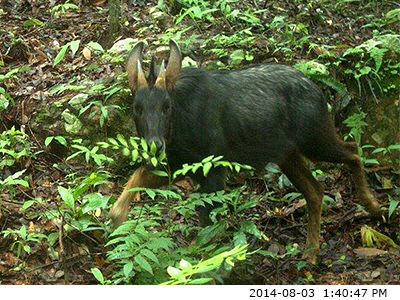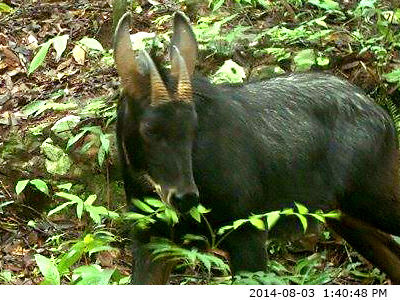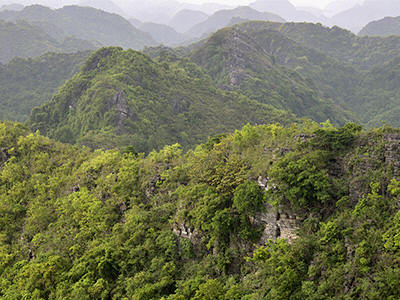 |
Fig 1
|
© Greg McCann |
 |
Fig 2
|
© Greg McCann |
 |
Fig 3
|
|
Order : CETARTIODACTYLA
Family : Bovidae
Species : Capricornis milneedwardsii
Shoulder
Height : up to 94 cm
Head-body Length : up to 155 cm
Tail : up to 16 cm
Weight : up to 160 kg
Serow are a type of ungulate (i.e. hoofed mammal) which are somewhat
goat-like in appearance. They inhabit hilly or rugged, mountainous areas
with steep slopes and rocky outcrops up to 4500 metres elevation. Such
habitat, which may offer sanctuary from predators such as big cats,
typically occurs in areas dominated by limestone karst.
Streams can be scarce in limestone hills, so the search for water may be one
factor which forces serow to descend to lower slopes with more gentle gradients.
Serow are also documented as swimming between isolated limestone islands.
Serow are secretive and mainly solitary in habits, and typically remain
hidden in thick forest by day. Their food preference, however, includes
tender, young leaves and shoots and the presence of fresh growth may draw
them out into the open to feed.
IUCN currently recognise 6 species of serow in the genus Capricornis, of
which three occur in Southeast Asia - the Chinese Serow (or Southwest China
Serow), Red Serow and Southern Serow.
The typical Chinese Serow has dark grey to black fur, with pale bases which
gives a greyish, grizzled appearance. The lower parts of its front and hind
legs is brownish, reddish or pale in colour. It has a short mane and
short beard, both of which may be greyish to white. Fur colour may vary
significantly between individuals and between populations.
Its body is stout with legs long, and the neck is short and thick. Its horns
are short, backward-curving horns, and are ringed or corrugated. It has
long, erect ears (typically longer than the horns). About 4 cm in front of
the eyes are a pair of glands. The tail is short.
The Chinese Serow
occurs in Myanmar, Thailand, Vietnam, Laos, Cambodia and parts of
southern China.
The species is threatened by forest loss and hunting, and increasingly
occurs in isolated, fragmented populations.
Figs 1 and 2 : Typical example of Chinese Serow, recorded by an automatic
trail camera at Virachey National Park, Cambodia.
Photos
thanks to Greg McCann.
Fig 3 : Example of forested habitat on steep, karst limestone hills on Cat
Ba Island, Vietnam. Chinese Serow numbers on this island have been
depleted by illegal hunting.
References :
Francis, C.M. 2019. A Field Guide to the Mammals of South-east Asia. Second
Edition. New Holland. 416 pp.
Lekagul, B., McNeely, J., 1977. Mammals of Thailand. Association for the
Conservation of Wildlife, Thailand. 758 pp.
Phan, T.D., Nijhawan, S., Li, S. & Xiao, L. 2020. Capricornis
sumatraensis. The IUCN Red List of Threatened Species 2020:
e.T162916735A162916910. |